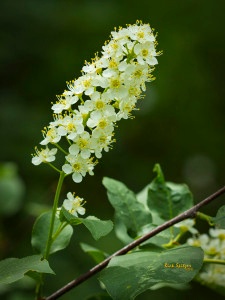 Roses are red and so are their fruits! And some of my favorite fruits to forage for in the Rose family are chokecherries! Chokecherries? A name like that can conjure up some unappetizing thoughts, but I insist, these are a not-to-miss late summer delight!
Roses are red and so are their fruits! And some of my favorite fruits to forage for in the Rose family are chokecherries! Chokecherries? A name like that can conjure up some unappetizing thoughts, but I insist, these are a not-to-miss late summer delight!
Although very much edible, chokecherry earns its unsavory name for a couple of reasons. One reason is due to their astringent taste as the berries are ripening. The longer the berries are allowed to ripen, the darker in color and sweeter they will become. The other reason is due to the unusually large pit at the center of the berry. Like most fruits in the Rose family, (apples, plums, peaches, etc.), chokecherry pits contain toxic amounts of cyanide and a number of deaths, mostly children, have been recorded from eating cherries without removing the pits. Cyanide also resides in the leaves of the chokecherry tree and can be dangerous to grazing livestock, moose, elk and deer. As the leaves of this tree begin to wilt, more cyanide is released giving the plant an even sweeter, but deadlier taste.
Despite these threats, chokecherries were still a very important part of the diets of many Native American tribes of the Northern Rockies, Northern Plains, and boreal forest regions of Canada and the United States. The bark of the root was made into a rough-textured concoction used to ward off or treat colds, fever and stomach maladies. The inner bark was used in smoking mixtures and the cherries themselves would be eaten raw or dried and used in pemmican, (dried meat or jerky), and other winter food mixes.
Today, chokecherries are used most often to make jams, jellies, juices and syrups! Adding the extra sugar helps alleviate the strong, bitter-sour taste of the fruit. This fruit is also added to apple jellies or wine for a special, wild flavor! Last winter, our very own Hannah Irwin, Community Programs Coordinator, made all of us here at Walking Mountains jars of chokecherry syrup for the holidays! This syrup was great on pancakes and on top of ice cream! I also loved adding it to plain yogurt and smoothies for a slightly sweet change of pace.
If you would like to get your hands on some fresh chokecherries this summer, get out on the trails and start looking for some prime picking sites! As the summer lags on, watch the berries begin to develop. Come back to your site often and do some taste tests as the berries ripen so you can decide for yourself when will be the best time to pick them. Remember to carry a good plant identification guide and make sure you are 100 percent certain you are picking chokecherries!
Nicole Abrams is the Girls in Science Coordinator at Walking Mountains Science Center. She loves fostering a sense of place in the natural world with the young ladies she mentors, inspiring them towards more sustainable habits.









